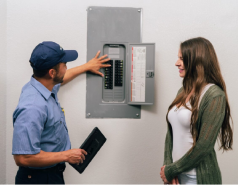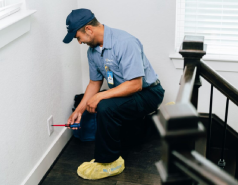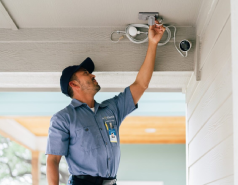Some of the most common types of safety outlets include:
AFCI Outlets
Arc fault circuit interrupter (AFCI) outlets are designed to detect arc faults—electrical discharges that occur when wiring becomes damaged or loose. These discharges create heat that can quickly lead to fires, especially behind walls or in attics where wiring is often hidden. AFCI outlets monitor the flow of electricity and shut off power when irregular arcing is detected. They are especially useful in bedrooms, living areas, and older homes where wiring may be more vulnerable.
GFCI Outlets
Ground fault circuit interrupter (GFCI) outlets are devices that are required in areas where water and electricity come into close proximity, such as bathrooms, kitchens, laundry rooms, garages, and basements. These outlets constantly monitor the electricity flow and respond within milliseconds if there is an imbalance, which can occur if electricity flows through a person instead of returning through the circuit. GFCI outlets help guard your home’s occupants from electrical shock and are necessary–and required–in environments where there is often water.
Outdoor Outlets
Outdoor electrical outlets need to withstand changing weather conditions, including rain, snow, and humidity. These outlets are typically installed with GFCI protection and weather-resistant covers to shield them from moisture and debris. Whether you need outdoor power for landscape lighting, gardening equipment, or holiday decorations, outdoor electrical outlets make it possible to access electricity safely beyond your home’s walls.
Tamper-Resistant or Childproof Outlets
Tamper-resistant outlets protect kids from accidental injury. These outlets have internal shutters that prevent foreign objects from being inserted into the slots unless equal pressure is applied to both prongs at the same time. This simple, yet effective, feature significantly reduces the risk of electrical shock for curious toddlers and children, making them a standard requirement in new residential construction.













